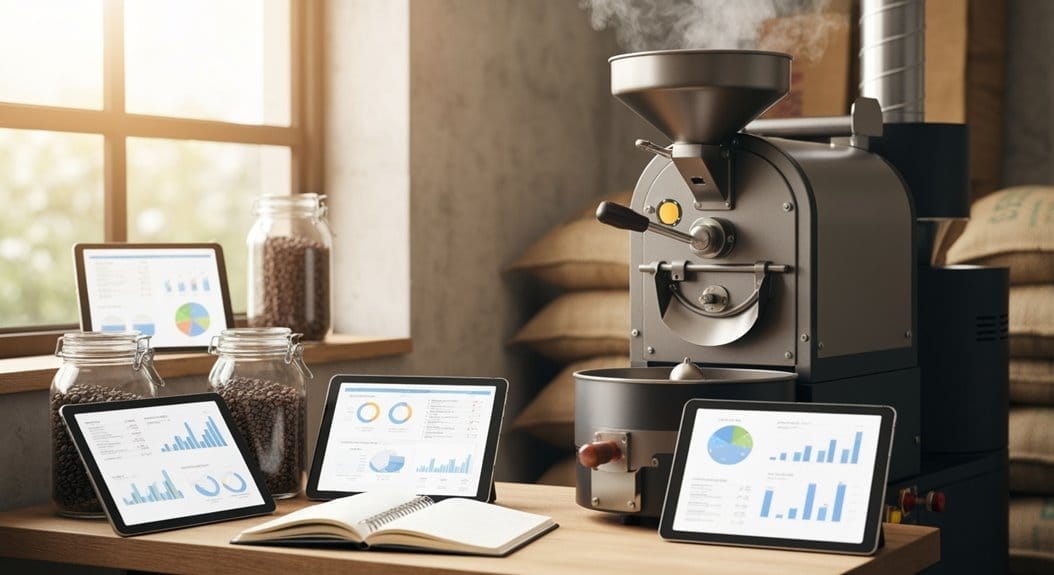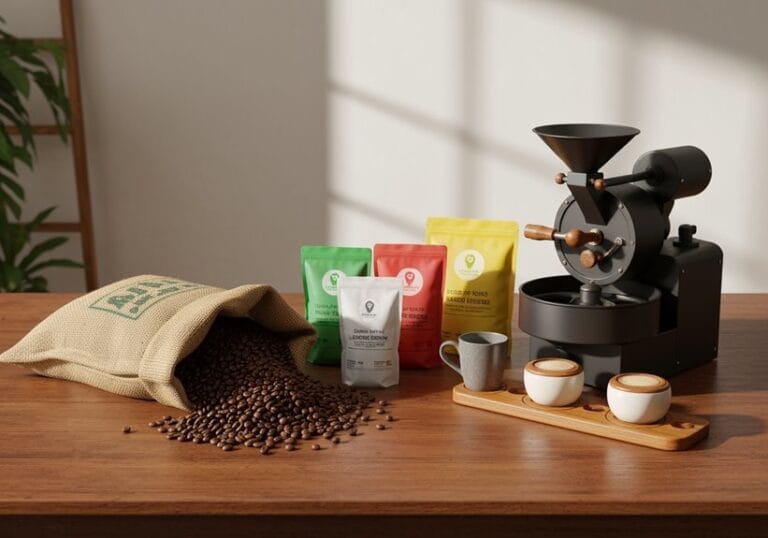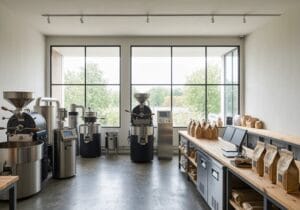So, you wanna start a coffee roasting business? Great choice! To begin, check the market—make sure folks actually want your beans! Next, grab some solid roasting equipment (the right tools can seriously make or break your coffee game). Sourcing quality beans? Taste-test like a pro! Then, create a fun brand and snag some eye-catching packaging. Keep an eye on your inventory to guarantee fresh coffee for your fans. And don’t forget to track those finances—nobody wants a cash flow crisis! Stick around, and you’ll get the full scoop.
Key Takeaways
- Conduct thorough market research to identify target audiences and trends in specialty and sustainable coffee practices.
- Acquire the appropriate roasting equipment while ensuring safety, efficiency, and proper installation for your business scale.
- Source high-quality coffee beans by building relationships with traders and farmers and tasting samples for evaluation.
- Establish a strong brand identity that resonates with consumers, focusing on storytelling and sustainable packaging.
- Monitor financials and inventory closely, utilizing software for efficiency and ensuring cash flow management for sustainable growth.
Conduct Market Research and Validate Demand

When dreaming up a coffee roasting business, the very primary step—market research—is like that initial sip of a perfectly brewed cup of joe: absolutely essential!
Knowing your target audience can be the difference between becoming a coffee connoisseur or just another cup of sad brew. With over 40,000 coffee shops blooming in the U.S. alone, it’s clear that coffee culture is alive and brewing! As the coffee culture transformed into global social hubs worldwide, understanding local preferences can greatly enhance your potential success. Notably, the premium coffee segment growing 34% YoY indicates a substantial consumer shift towards higher-quality offerings.
Understanding your audience is crucial—it’s the difference between coffee excellence and a bland cup of regret!
Keep an eye on market trends—like the upward urge for specialty coffee and sustainable practices. You don’t want to roast beans in a vacuum! The coffee roaster market’s projected CAGR of 4.70% highlights the increasing consumer interest in premium coffee experiences, which makes your research even more critical.
Conversations with coffee-loving friends may reveal surprising insights and tastes. Plunge deep, investigate flavors—who knows? You might find your next latte-slamming genius idea!
Acquire and Install Reliable Roasting Equipment
When it comes to choosing roasting equipment, the options are about as varied as coffee drinkers themselves—seriously, you’ve got everything from those slow and steady drum roasters that could take your beans on a relaxing vacation, to speedy fluid bed roasters that could roast beans faster than your morning routine (and believe me, that’s a feat!).
Then there are installation quirks to take into account—like, does your floor have the muscle to handle that big, bad roaster? (Yeah, we’ve all learned that the hard way; nothing like rethinking your life choices while staring at a smushed floor!)
Equipment Selection Criteria
For any aspiring coffee roasting entrepreneur, selecting the right equipment can feel like trying to find the perfect brew on a Monday morning—overwhelming and a bit chaotic!
Primarily and foremost, think about equipment efficiency. It’s not just about getting the beans roasted; it’s about how quickly, consistently, and cost-effectively you can do it!
Maybe you prefer a drum roaster for that smooth, rich flavor, or perhaps a speedy air roaster for quick turns—talk about roasting versatility!
Remember, size matters too; don’t get a giant roaster if you’re just filling a coffee shop corner! It’s like using a sledgehammer to crack a nut—overkill and messy!
Additionally, ensure your choice aligns with your desired roasting method to achieve the flavor profiles you wish to develop.
Equip wisely, and may your beans never burn!
Installation Considerations
Choosing the right equipment is just the preliminary step in what can feel like a rollercoaster ride of excitement and anxiety—because installation is where the magic (or chaos) happens!
First off, you’ll need ventilation systems—think of them as your roaster’s best friend. Without them, you might just turn your cozy shop into a smokehouse!
Clear space around the roaster isn’t just a suggestion; it’s a must, allowing for air and making sure your walls don’t play hide-and-seek with flames.
Oh, and don’t forget safety protocols—like placing fire extinguishers and a detailed plan for emergencies right next to your roaster.
Source Quality Green Coffee Beans

Sourcing quality green coffee beans is, believe it or not, a bit like trying to pick the perfect avocado at the grocery store—easy to mess up, and you’ll probably end up with a rock-hard disappointment or a mushy disaster if you’re not careful!
Choosing the beans involves some serious sourcing methods, like checking the variety and origin. And don’t even get me started on quality evaluation—those hidden defects can be sneakier than a cat in a room full of rocking chairs! Understanding the variety classification of coffee can significantly influence your sourcing choices, as certain types offer different flavor profiles.
Plus, understanding your customers’ tastes can feel like reading minds! Starting with traders can ease the pain before hitting up farmers directly. It’s all about building those relationships—trust is key, just like with that avocado (which, by the way, still hasn’t ripened). Evaluating coffee quality through tasting samples can help ensure you don’t make a bad choice.
Establish Branding, Packaging, and Marketing Strategies
When launching a coffee roasting business, establishing branding, packaging, and marketing strategies is almost like trying to juggle while riding a unicycle—challenging but oh-so-rewarding if done right!
Initially, a brand’s identity needs to sing, showcasing unique beans or artisan techniques, much like how a superhero needs a cool costume!
Then there’s packaging—it’s gotta shout your story! Think beautiful designs and eco-friendly materials that say, “Look at me, I care about the planet.”
Now, onto marketing; engage those young, brew-loving folks with social media magic and relatable storytelling. Consistent vibes across logos and colors? A must!
Implement Roasting Processes for Quality and Consistency

Quality and consistency in coffee roasting can feel like trying to herd cats—exciting but a little chaotic if not managed just right! To keep things calm in the roaster world, focus on:
- Temperature control for perfect batch uniformity
- Roasting schedules that allow for moisture management
- Cooling techniques to maintain flavor consistency
Every roast is a balancing act. Preheating your roaster is as essential as a morning cup of coffee, ensuring even heat for the green beans.
And don’t forget that drying stage—it’s a delicate dance of flavors! The Maillard reaction? That’s your flavor party!
The drying stage is where flavors start their dance, and the Maillard reaction kicks off the ultimate flavor celebration!
But the real kicker? Proper equipment maintenance means no more misbehaving machines! A little planning, and voilà, you’ve got quality coffee that’ll keep customers coming back.
Manage Inventory and Logistics for Fresh Product Delivery
Managing inventory and logistics for fresh product delivery is like trying to juggle flaming coffee mugs—challenging, but oh-so-rewarding if you can pull it off!
Visualize this: you’ve got roasting schedules, suppliers, and that precious green bean stock competing for your attention. By harnessing inventory automation through clever software like RoasterTools, you can track your beans like they’re your own caffeine-fueled children, all while avoiding sneaky stockouts.
And let’s not forget logistics optimization! Prioritizing shipments based on freshness keeps customers happy (and your coffee hot). With real-time updates, tracking expiry dates, and maintaining quality control, you’ll guarantee that every cup of joe is as fresh as it gets, leaving customers wondering how you pulled off that magic trick!
Monitor Financials and Refine Operations

Keep a close watch on those financials if you want to avoid the sinking feeling of watching a perfectly roasted bag of beans go stale!
Managing a coffee roasting business is like brewing that perfect cup—too much heat, and it’s bitter; too little, and it’s just weak. So, immerse yourself in financial analysis and keep tabs on performance metrics to refine operations!
- Track gross profit margin—know your efficiency!
- Measure roasting cycle times—time is money!
- Conduct cash flow forecasts—predicting your liquidity is key!
Frequently Asked Questions
What Are the Legal Requirements for Starting a Coffee Roasting Business?
Legal requirements for establishing a coffee roasting operation include obtaining necessary permits and licenses, ensuring food safety compliance, and adhering to health regulations. Furthermore, environmental permits may be necessary depending on roasting volume and location.
How Can I Build a Customer Base for My Coffee Brand?
To build a customer base, one must focus on community engagement and improve online presence. This includes leveraging social media, hosting local events, and creating authentic connections through educational content and personalized promotions that resonate with customers.
What Potential Partnerships Can Benefit My Coffee Roasting Business?
Potential partnerships for the business include collaborating with wholesale suppliers, establishing relationships with local cafes, sourcing from sustainable farms, and connecting through distribution networks, enhancing product quality, availability, and brand visibility in the market.
How Do I Price My Roasted Coffee Products Competitively?
To price roasted coffee products competitively, one must conduct a thorough cost breakdown and competitor analysis, factoring in green bean costs, roasting expenses, and market trends, while ensuring prices align with target consumer segments and profit margins.
What Marketing Strategies Work Best for Coffee Roasters?
Effective marketing strategies for coffee roasters include leveraging social media for engagement and brand storytelling, along with participating in trade shows to improve visibility and establish connections within the coffee community, fostering customer loyalty and trust.
References
- https://smallbiztrends.com/how-to-start-a-coffee-roasting-business/
- https://www.coffeeforums.com/threads/profitability-in-roasting.16306/
- https://www.serif.ai/start-a-business/how-to-start-a-coffee-roasting-business-2025-guide-12-steps-free-business-plan
- https://www.verifiedmarketresearch.com/product/coffee-roaster-market/
- https://www.grandviewresearch.com/industry-analysis/coffee-roaster-market-report
- https://www.zionmarketresearch.com/report/coffee-beans-roaster-market
- https://www.ibisworld.com/united-states/industry/coffee-production/272/





